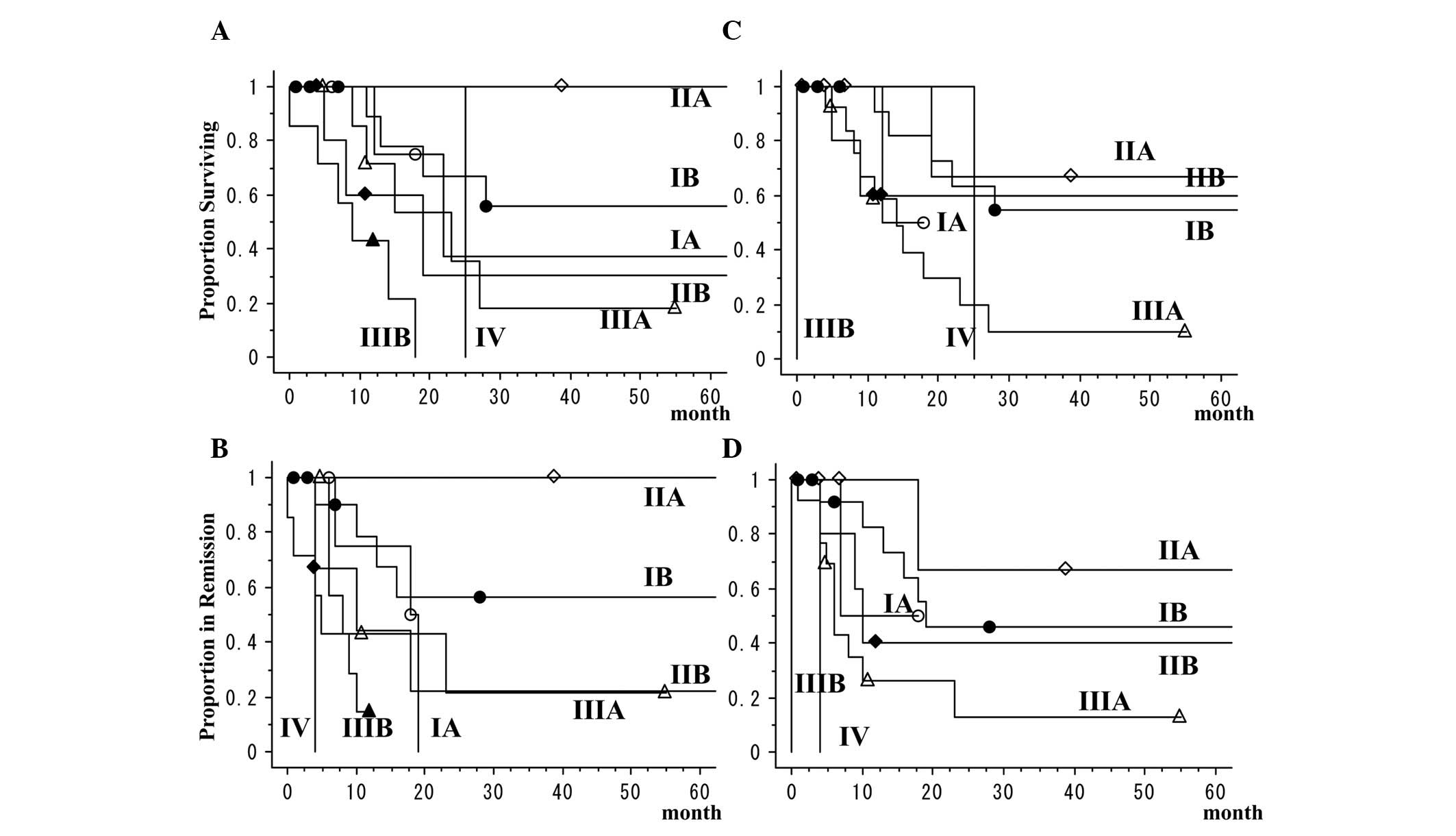|
1.
|
Travis WD, Colby TV, Corrin B, Shimosato Y
and Brambilla E: Histological Typing of Lung and Pleural Tumours.
World Health Organization International Histological Classification
of Tumors, XIII. 3rd edition. Springer-Verlag; Berlin/Heidelberg:
1999
|
|
2.
|
Iyoda A, Hiroshima K, Nakatani Y and
Fujisawa T: Pulmonary large cell neuroendocrine carcinoma: its
place in the spectrum of pulmonary carcinoma. Ann Thorac Surg.
84:702–707. 2007.PubMed/NCBI
|
|
3.
|
Iyoda A, Hiroshima K, Toyozaki T, Haga Y,
Fujisawa T and Ohwada H: Clinical characterization of pulmonary
large cell neuroendocrine carcinoma and large cell carcinoma with
neuroendocrine morphology. Cancer. 91:1992–2000. 2001. View Article : Google Scholar : PubMed/NCBI
|
|
4.
|
Asamura H, Kameya T, Matsuno Y, et al:
Neuroendocrine neoplasms of the lung: a prognostic spectrum. J Clin
Oncol. 24:70–76. 2006. View Article : Google Scholar : PubMed/NCBI
|
|
5.
|
Iyoda A, Hiroshima K, Moriya Y, et al:
Pulmonary large cell neuroendocrine carcinoma demonstrates high
proliferative activity. Ann Thorac Surg. 77:1891–1895. 2004.
View Article : Google Scholar : PubMed/NCBI
|
|
6.
|
Iyoda A, Hiroshima K, Baba M, Saitoh Y,
Ohwada H and Fujisawa T: Pulmonary large cell carcinomas with
neuroendocrine features are high-grade neuroendocrine tumors. Ann
Thorac Surg. 73:1049–1054. 2002. View Article : Google Scholar : PubMed/NCBI
|
|
7.
|
Onuki N, Wistuba II, Travis WD, et al:
Genetic changes in the spectrum of neuroendocrine lung tumors.
Cancer. 85:600–607. 1999. View Article : Google Scholar : PubMed/NCBI
|
|
8.
|
Jones MH, Virtanen C, Honjoh D, et al: Two
prognostically significant subtypes of high-grade lung
neuroendocrine tumours independent of small-cell and large-cell
neuroendocrine carcinomas identified by gene expression profiles.
Lancet. 363:775–781. 2004. View Article : Google Scholar
|
|
9.
|
Hiroshima K, Iyoda A, Shibuya K, et al:
Genetic alterations in early-stage pulmonary large cell
neuroendocrine carcinoma. Cancer. 100:1190–1198. 2004. View Article : Google Scholar : PubMed/NCBI
|
|
10.
|
Goldstraw P, Crowley J, Chansky K, et al:
International Association for the Study of Lung Cancer
International Staging Committee. The IASLC Lung Cancer Staging
Project: proposals for the revision of the TNM stage groupings in
the forthcoming (seventh) edition of the TNM Classification of
malignant tumours. J Thorac Oncol. 2:706–714. 2007.
|
|
11.
|
Jiang SX, Kameya T, Shoji M, Dobashi Y,
Shinada J and Yoshimura H: Large cell neuroendocrine carcinoma of
the lung. A histologic and immunohistochemical study of 22 cases.
Am J Surg Pathol. 22:526–537. 1998. View Article : Google Scholar : PubMed/NCBI
|
|
12.
|
Therasse P, Arbuck SG, Eisenhauer EA, et
al: New guidelines to evaluate the response to treatment in solid
tumors European Organization for Research and Treatment of Cancer,
National Cancer Institute of the United States, National Cancer
Institute of Canada. J Natl Cancer Inst. 92:205–216. 2000.
View Article : Google Scholar
|
|
13.
|
Veronesi G, Morandi U, Alloisio M, et al:
Large cell neuroendocrine carcinoma of the lung: A retrospective
analysis of 144 surgical cases. Lung Cancer. 53:111–115. 2006.
View Article : Google Scholar : PubMed/NCBI
|
|
14.
|
Takei H, Asamura H, Maeshima A, et al:
Large cell neuroendocrine carcinoma of the lung: a
clinicopathologic study of eighty-seven cases. J Thorac Cardiovasc
Surg. 124:285–292. 2002. View Article : Google Scholar : PubMed/NCBI
|
|
15.
|
Rossi G, Cavazza A, Marchioni A, et al:
Role of chemotherapy and the receptor tyrosine kinases KIT,
PDGFRalpha, PDGFRbeta, and Met in large-cell neuroendocrine
carcinoma of the lung. J Clin Oncol. 23:8774–8785. 2005. View Article : Google Scholar : PubMed/NCBI
|
|
16.
|
Travis WD, Rush W, Flieder DB, et al:
Survival analysis of 200 pulmonary neuroendocrine tumors with
clarification of criteria for atypical carcinoid and its separation
from typical carcinoid. Am J Surg Pathol. 22:934–944. 1998.
View Article : Google Scholar : PubMed/NCBI
|
|
17.
|
Paci M, Cavazza A, Annessi V, et al: Large
cell neuroendocrine carcinoma of the lung: a 10-year
clinicopathologic retrospective study. Ann Thorac Surg.
77:1163–1167. 2004.PubMed/NCBI
|
|
18.
|
Battafarano RJ, Fernandez FG, Ritter J, et
al: Large cell neuroendocrine carcinoma: an aggressive form of
non-small cell lung cancer. J Thorac Cardiovasc Surg. 130:166–172.
2005. View Article : Google Scholar : PubMed/NCBI
|
|
19.
|
Skuladottir H, Hirsch FR, Hansen HH and
Olsen JH: Pulmonary neuroendocrine tumors: incidence and prognosis
of histological subtypes. A population-based study in Denmark. Lung
Cancer. 37:127–135. 2002. View Article : Google Scholar : PubMed/NCBI
|
|
20.
|
Iyoda A, Hiroshima K, Moriya Y, et al:
Postoperative recurrence and the role of adjuvant chemotherapy in
patients with pulmonary large-cell neuroendocrine carcinoma. J
Thorac Cardiovasc Surg. 138:446–453. 2009. View Article : Google Scholar : PubMed/NCBI
|
|
21.
|
Yamazaki S, Sekine I, Matsuno Y, et al:
Clinical responses of large cell neuroendocrine carcinoma of the
lung to cisplatin-based chemotherapy. Lung Cancer. 49:217–223.
2005. View Article : Google Scholar : PubMed/NCBI
|
|
22.
|
Iyoda A, Hiroshima K, Toyozaki T, et al:
Adjuvant chemotherapy for large cell carcinoma with neuroendocrine
features. Cancer. 92:1108–1112. 2001. View Article : Google Scholar : PubMed/NCBI
|
|
23.
|
Iyoda A, Hiroshima K, Moriya Y, et al:
Prospective study of adjuvant chemotherapy for pulmonary large cell
neuroendocrine carcinoma. Ann Thorac Surg. 82:1802–1807. 2006.
View Article : Google Scholar : PubMed/NCBI
|
|
24.
|
Kamiyama H, Ikeya T, Suda K, Murai K,
Aoyama K and Hoshi E: Second primary digestive cancer after
resection of lung cancer. Surg Today. 34:577–580. 2004. View Article : Google Scholar : PubMed/NCBI
|
|
25.
|
Battafarano RJ, Force SD, Meyers BF, et
al: Benefits of resection for metachronous lung cancer. J Thorac
Cardiovasc Surg. 127:836–842. 2004. View Article : Google Scholar : PubMed/NCBI
|
|
26.
|
Johnson BE: Second lung cancers in
patients after treatment for an initial lung cancer. J Natl Cancer
Inst. 90:1335–1345. 1998. View Article : Google Scholar : PubMed/NCBI
|











